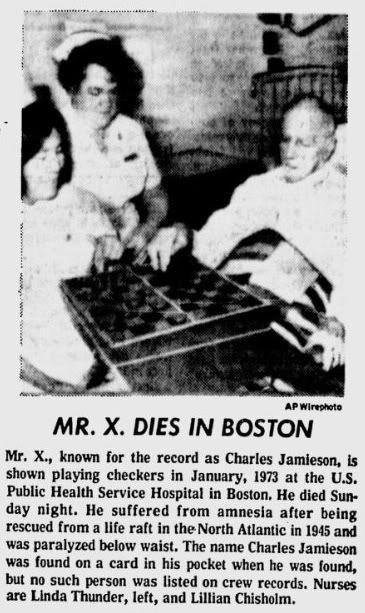Mon 15 Aug 2011
Today’s mystery: Mr. X
Posted by PJ under memories, mysteries, today's mystery
No Comments
In February 1945—or maybe it was 1942. The newspapers disagree. In February, 1945, reports the AP wire service of January 21, 1975, a man who appeared to be in his forties was found floating in a life raft in the North Atlantic. He had head and internal injuries and was paralyzed from the waist down, unable to speak, though he’d nod yes or shake his head no sometimes when asked questions. For all anyone could tell, he was completely unable to remember who he was or how he got in that raft. He carried no identification, but there was a card in his pocket with the name Charles Jamieson on it, and the birth date of April, 1898. So that was the name they listed on his hospital records.
Stars and Stripes of March 30, 1957, reports that an ambulance brought him to the U.S. Public Health Hospital in Boston on February 10, 1942, then sped off, never to be traced. Several government agencies carried on searches to identify him without any luck, and it was speculated that he’d been on board a merchant ship torpedoed by a Nazi sub.
And yet the name Charles Jamieson did not appear on any crew records of any ship sunk during that time.
In March of 1957 Mrs. Frances Hamilton, then of Long Beach, CA but born in England, claimed that Charles was her long-lost brother, James Hamilton, a British merchantman, whom she hadn’t seen since 1921. However, not even the British consul believed her, reporting that she produced no “concrete proof” that Charles was her brother, and furthermore, that she herself seemed rather confused. She told rambling and incoherent stories about her brother James, and although a “tearful reunion” took place between Mrs. Hamilton (who had taken back her maiden name after a divorce) and Charles, he didn’t respond to her in any way except for the same peaceful smile he gave to anyone who talked to him.
The link was dismissed as wishful fantasy on Mrs. Hamilton’s part.
Charles lived on at the U.S. Public Health Hospital for nearly 30 years. A sweet-natured man, no one ever knew how much he comprehended of his situation and his environment. He liked candy, liked to be wheeled around the hospital—and had plenty of willing volunteers to take him. Occasionally, he played checkers and responded to music on the radio. Everyone who passed him in the halls stopped to speak, to benefit from his sweet smile and peaceful nature. “He was—you could almost say—loved by every member of the staff,” said George Hedquist, assistant director of the hospital, “almost as if he were a mascot or a member of the family.”
The man who became know as Charles Jamieson had clearly lived through horrors, but he brought none of them with him on that bitter journey across the Atlantic and into the safe harbor of the U.S. Public Health Hospital of Boston, Mass. Nothing there, no, no, nothing there to think on, nothing there. . .
“Charles Jamieson” died in January of 1975, still unknown, having never spoken a word in all those years. The Transcript of January 23, 1975 reports that 100 people attended the funeral of sweet, mysterious Mr. X.


